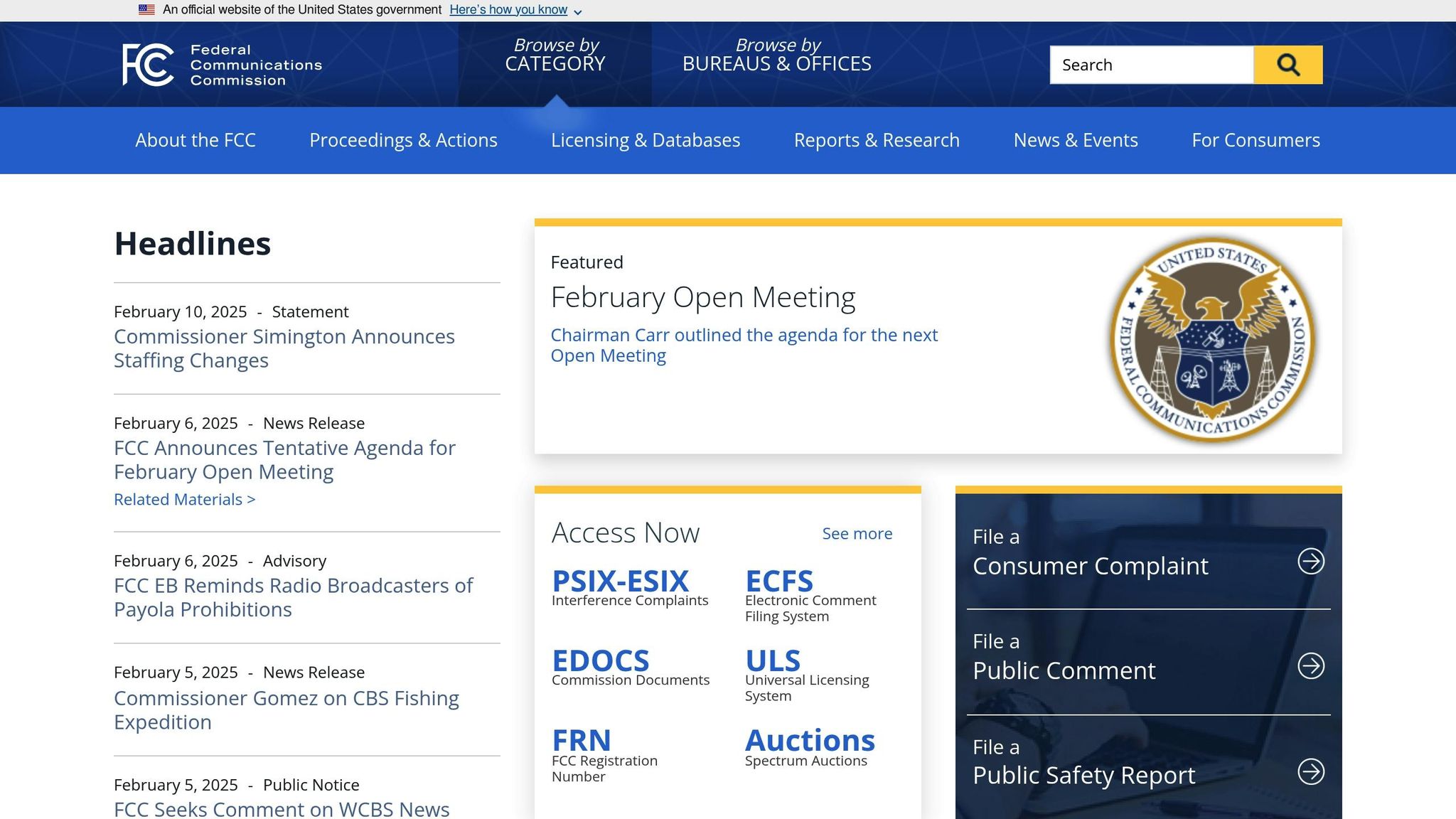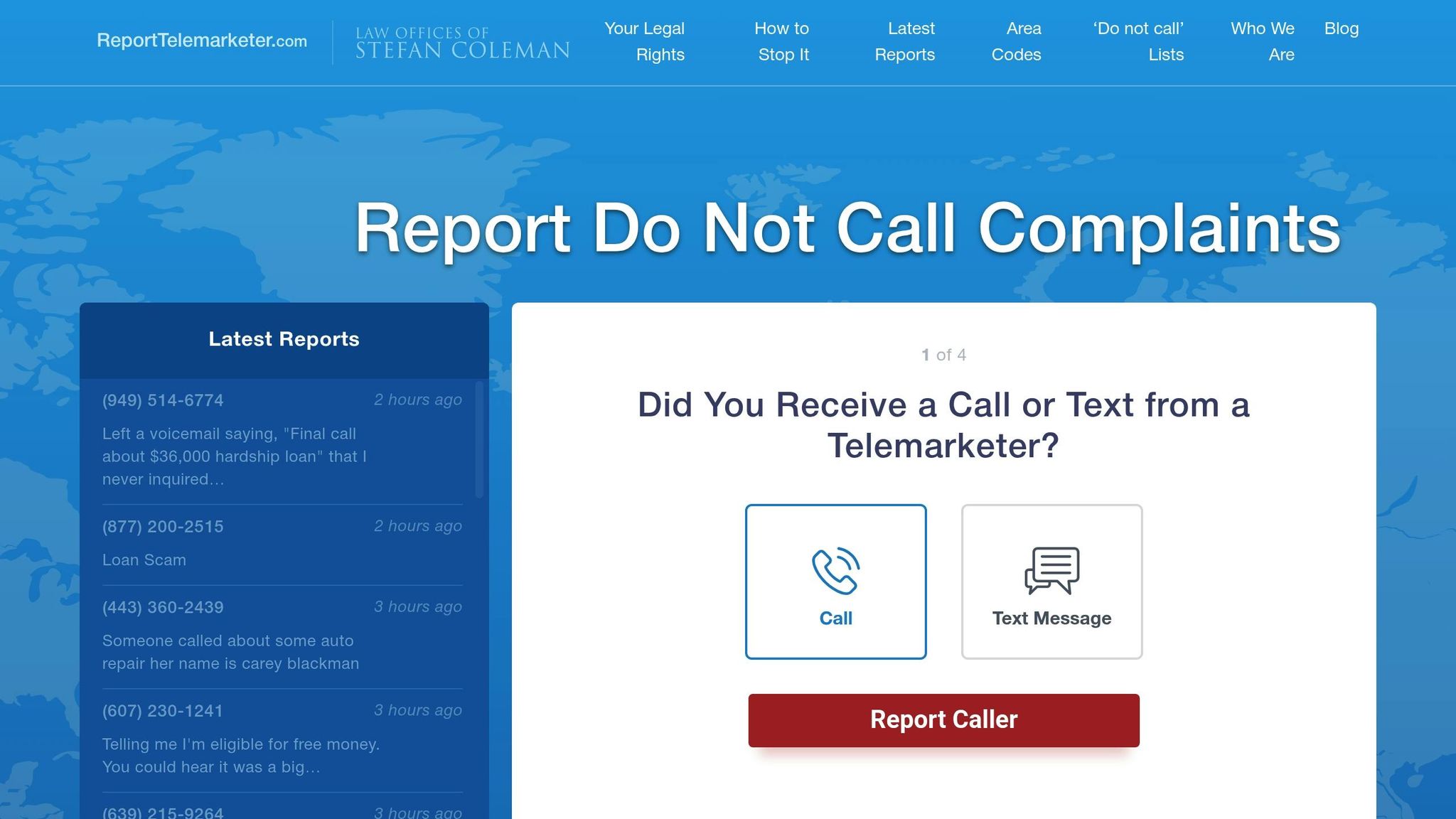
Filing a complaint with the FCC is straightforward and helps address issues like unwanted calls, billing disputes, slow internet, and more. Here’s what you need to know:
- What You Need: Contact details, provider info, issue details (dates, logs, bills, etc.).
- How to File: Use the FCC Consumer Complaint Center online, call 1-888-225-5322, or send mail to their Washington, DC office.
- Timeline: Providers must respond within 30 days. Non-responses escalate to enforcement after 35 days.
- Options for Escalation: If unsatisfied, submit rebuttals or file a formal complaint (cost: $605).
For telemarketing issues, include call logs and use tools like ReportTelemarketer.com to strengthen your case. Most complaints are resolved within 60 days when properly documented.
How to File a Complaint with the Federal Communications Commission
Before Filing Your Complaint
Getting everything in order before filing your complaint with the FCC can help speed up the process through the FCC’s Consumer Complaint Center.
Types of FCC Complaints

The FCC handles complaints in these main categories:
| Complaint Category | Percentage of Total | Common Examples |
|---|---|---|
| Telemarketing/Robocalls | 58% | Calls after opting out, automated messages |
| Billing Disputes | 22% | Unapproved charges, hidden fees |
| Service Quality | 12% | Slow internet, outages |
| Privacy Violations | 5% | Violations of CPNI rules |
| Equipment Problems | 3% | Issues with routers or modems |
Required Information
What You’ll Need:
- Your Contact Details
- Full name
- Current address
- Best phone number
- Email address
- Service Provider Details
- Provider’s name and your account number
- Service address
- Names of any representatives you’ve spoken to
- Details About the Issue
- Dates and times of incidents
- Call logs or screenshots
- Marked-up copies of bills (for billing disputes)
- Records of service outages
- Any past communication with the provider
The FCC resolves 89% of complaints with complete documentation within 60 days.
Tips for Better Documentation:
"Reference specific FCC regulations in your complaint, focus on one issue at a time, and include third-party evidence like screen recordings for service-related problems", advise FCC legal experts.
To make things easier, you can use FCC’s bill annotation templates (available at consumercomplaints.fcc.gov) to clearly highlight disputed charges. Missing details are a common problem – 32% of complaints are rejected for uncircled charges, and 41% need resubmission due to missing dates of interaction.
Once your documentation is ready, you can move on to selecting a submission method.
Filing Methods
The FCC offers several ways to submit consumer complaints, with online filing being the fastest and most straightforward option.
How to Submit Online
The FCC Consumer Complaint Center portal makes filing a complaint simple with its step-by-step guided form. Here’s how to do it:
1. Start by Logging In
Visit consumercomplaints.fcc.gov and create an account. The system will automatically save your draft as you go.
2. Pick the Right Category
Select the appropriate complaint category from the dashboard. The form will adjust based on your selection, ensuring you include all the necessary details for your issue.
Filing by Phone or Mail
If online filing isn’t an option, you can submit your complaint via phone or mail.
- Phone Submission: Call one of these numbers depending on your needs:
- Standard: 1-888-225-5322
- ASL Video: 1-844-432-2275
- TTY: 1-888-835-5322
- Mail Submission:
According to FCC processing data, certified mail submissions are processed 23% faster thanks to delivery confirmation.
Send your complaint with a "FCC Complaint" cover letter and numbered documents to:
Federal Communications Commission
Consumer Complaint Center
45 L Street NE
Washington, DC 20554
Make sure to keep your tracking number handy for checking the status of your complaint later.
sbb-itb-a8d93e1
Next Steps
After submitting your complaint through the FCC’s online portal, by phone, or via mail, the next phase involves keeping track of the process and understanding potential outcomes.
Complaint Status Updates
Once your complaint is filed, the FCC’s Consumer Inquiries and Complaints Division reviews it and assigns a tracking number. You’ll receive email updates as your case progresses. By law, the service provider has 30 days to respond to your complaint.
Here’s a breakdown of the typical timeline:
| Stage | Duration | Action |
|---|---|---|
| Initial Processing | 1-3 days | FCC reviews and assigns tracking number |
| Provider Response | Up to 30 days | Company investigates and responds |
| Auto-Escalation | After 35 days | Non-responsive cases sent to Enforcement |
| Resolution | Varies | Provider resolves or FCC takes enforcement action |
When Results Fall Short
If the provider’s response doesn’t meet your expectations, there are additional steps you can take. According to FCC data, around 22% of informal complaints require further follow-up, with telecommunications issues having the highest escalation rate at 31%.
To strengthen your case for further action:
- Submit rebuttals: Respond within 10 days of receiving the provider’s reply, adding any new evidence or details.
- File a Formal Complaint: If the informal process doesn’t work, you can file a formal complaint within six months. This process costs $605, typically requires legal counsel, and results in legally binding rulings within six months.
"The FCC automatically escalates non-responsive cases to its Enforcement Bureau after 35 days."
For ongoing telemarketing problems, the next section outlines specialized resources that may help.
Telemarketing Complaints
Unwanted telemarketing calls and texts are among the most frequent complaints filed with the FCC. To address these issues, the FCC has put in place strict protocols and protections aimed at minimizing their impact on consumers.
Do Not Call Violations
When reporting violations of the Do Not Call rules, the FCC requires specific documentation. Here’s what you need to include:
| Required Documentation | Details to Include |
|---|---|
| Call Information | Date, time, and how often the calls occur |
| Caller Details | Phone numbers and company names |
| Communication Records | Call recordings or screenshots of text messages |
For ongoing issues, services like ReportTelemarketer.com can provide additional support to strengthen your FCC complaint.
How ReportTelemarketer.com Helps

ReportTelemarketer.com offers tools and resources that go beyond the standard complaint process. Here’s what they provide:
- Automated evidence collection, including call recording
- Tracking of violations and tracing spoofed numbers
- Pre-filled FCC complaint templates for easier filing
Their efforts have led to tangible results. For instance, one case resulted in a $12,000 settlement for a consumer and a $184,000 fine imposed by the FCC. The service operates without upfront costs, as attorneys recover fees directly from penalized telemarketers under the TCPA.
"Through coordinated FTC/FCC filings and litigation threats, ReportTelemarketer.com achieved complete operation shutdown of illegal telemarketers within 60 days, while securing compensation for affected consumers" [provider data]
Their approach has been highly effective, with 89% of cases resolved without the need for formal FCC complaints.
Summary
Filing a complaint with the FCC requires clear documentation and an understanding of how the resolution process works. Providers are obligated to respond to informal complaints within 30 days.
The FCC offers a structured process for addressing telecommunications issues, giving consumers multiple ways to report problems. This process is especially effective for dealing with telemarketing violations. Services like ReportTelemarketer.com play a key role by coordinating filings, which helps the FCC take action more efficiently.
The Do Not Call Registry works alongside consumer protection services to tackle unwanted calls and texts. This collaboration ensures that complaints are addressed while focusing on legitimate concerns.
To improve your chances of a resolution, maintain thorough records and regularly check FCC updates to track the status of your complaint.
FAQs
Does filing a complaint with the FCC do anything?
Yes, it can. While filing a complaint with the FCC doesn’t guarantee a personal resolution, it plays a key role in shaping regulations and can lead to enforcement actions. The FCC uses these complaints to spot industry-wide problems and address them.
Here’s how FCC complaints can make an impact:
- Provider Responses: Many complaints result in responses from service providers, often resolving individual issues.
- Investigations and Penalties: Complaints about serious violations can lead to investigations and penalties.
- Policy Changes: Patterns in complaints influence regulatory updates, like the adoption of STIR/SHAKEN technology to combat robocalls.
These actions align with the outcomes seen through ReportTelemarketer.com’s coordinated efforts.
If you’re not satisfied with the informal complaint process, you can escalate to a formal complaint. This step requires legal counsel and comes with a $605 filing fee, though fee waivers are available for those facing financial hardships under FCC Rule 1.1116.